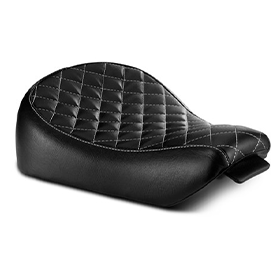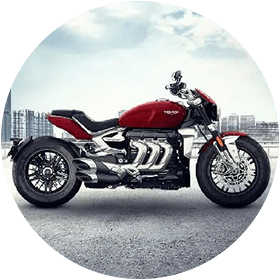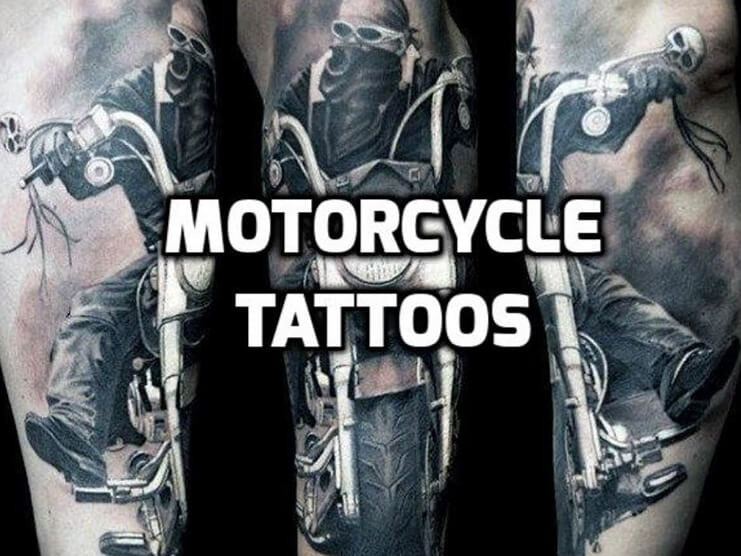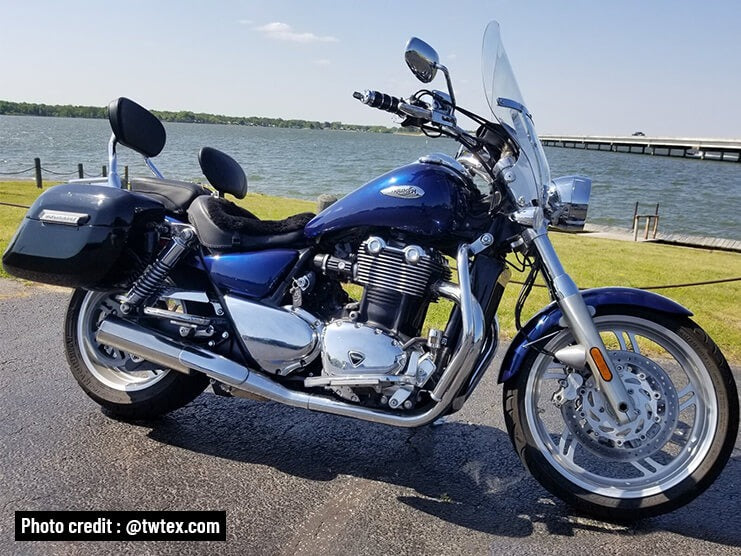- Table of Contents
- 1. A Brief History of Triumph Rocket III Roadster
- 2. Triumph Rocket III Roadster At First Glance
- 3. Triumph Rocket III Roadster: A Buyer’s Guide
- 3.1 What Engine Size does a Triumph Rocket III Roadster Have?
- 3.2 What is the Top Speed of a Triumph Rocket III Roadster?
- 3.3 Does Triumph Rocket III Roadster has Cruise Control System?
- 3.4 What is the Weight of a Triumph Rocket III Roadster?
- 4. Triumph Rocket III Roadster Specifications
- 4.1 Class, Model & Year
- 4.2 Suspension & Chassis
- 4.3 Engine, Transmission & Exhaust System
- 4.4 Body Dimensions, Capacities & Weight
- 4.5 Wheels, Tires & Brakes
- 4.6 Color Options, Ignition & Instruments
- 5. Aftermarket Parts & Luggage Options For Triumph Rocket III Roadster
When a motorcyclist tells you that size counts, they are not kidding. The best motorcycles have powerful powertrains that can reduce a three-hour journey to a 30-minute joyride. There are many different types of motorcycles and the one you choose will depend on a number of factors.
There are several factors to consider when riding a bike, including the terrain, seat height, and type of motorcycle (cruiser or sports). Whatever decision you make, displacement will always be an issue. Whether you choose a sports bike or a cruiser, you must determine the appropriate capacity.
If you are one of those riders who want to experience a powerful motorcycle with a big displacement and built around the frame of a cruiser, Triumph has a motorcycle for you. The Rocket III Roadster is the world’s largest displacement motorcycle, known for its muscular stance and being a power cruiser with few equals.
Read on to find out the history, performance, specifications, and more about the Triumph Rocket III Roadster.
1. A Brief History of Triumph Rocket III Roadster
The Triumph Cycle Co. Ltd. created the first Triumph motorcycle in Coventry, England in 1902. The business first imported sewing machines and then sold bicycles before they began constructing motorcycles.
The first Triumph motorcycle was just a bicycle frame with a single-cylinder Belgian Minerva engine mounted to the downtube. Until 1905, when the first all-Triumph models were released, Triumphs were powered by Belgian Minerva engines, then JAP engines.
Triumph had already established itself as a significant player in the world of competitive motorcycle racing by 1907. The company first produced a 450cc type and up to 1,000 cycles could be produced annually.
Triumph unveiled a number of new machines during the next three decades while also making constant updates to its older models. Triumph focused its production from 1915 to 1918 on providing motorcycles to the Allies fighting in World War I. The new 500cc Speed Twin model was introduced in 1937.
Triumph was a privately held British business known for its own distinct personality and history of producing motorcycles. By the 1980s, Triumph had shut down operations along with the rest of the British motorcycle industry.
In the 1990s, British industrialist John Bloor brought Truiph back to life and the company started creating a line-up of modern sportbikes and throwbacks with retro themes.
However, the Rocket III Project began in 1998 under the direction of Ross Clifford, Triumph Product Range Manager, and required extensive study, particularly in the U.S., where large cruisers were in high demand.
At that time, the Harley-Davidson Electra Glide and the Honda Gold Wing were the main rivals, thus Triumph’s original plan was to create a 1,600 cc performance cruiser. An in-house designer named John Mocett started working around an in-line three-cylinder engine.
At the beginning of the project, in-line four and V6 engine designs were taken into consideration, but the longitudinally positioned triple design ultimately gave rise to the design concept and was termed S1. It was presented with a large chrome mudguard at the rear and raygun mufflers to appeal to consumers but this design was ultimately disapproved.
Afterward, the S2 design was presented as a condensed version that included various improvements that would eventually make it into the final design, including a rear mudguard that was more conventional. Again, market research indicated that it was still too extreme, so the Series S3’s lines were streamlined and smoothed out in response.
The competition from other producers was one of the factors contributing to the secrecy. Triumph made the decision to boost the ante and go for a displacement of 2,294 ccs after Yamaha and Honda debuted the 1670 cc Road Star Warrior and the VTX1800 respectively in 2002.
Following market research, the prototype’s name was changed to “Rocket” in 2003, carrying on the legacy of the BSA Rocket 3/Triumph Trident motorcycles. On August 20, 2003, in San Antonio, Texas, this bike was introduced in the U.S. On September 16, 2003, the International Motorcycle Show in Milan Italy hosted the Rocket’s European debut.
It began to be sold in the U.K. in the spring of 2004 and was named “Machine of the Year” at the 2004 NEC Motorcycle Show by Motorcycle News. 230 deposits were collected for the Australian debut in Sydney in August 2004 before any products had even been delivered to the nation.
The model was originally named Rocket III and was available in the following trims:
| Rocket III Models |
|---|
| Rocket III Classic |
| Rocket III Roadster |
| Rocket III Tourer |
| Rocket III Touring |
The Rocket III Roadster was introduced in 2010 and nominated as the most powerful motorcycle in the Rocket III lineup. It is also the only version currently available. Moreover, Triumph also awarded the Rocket III Roadster with the “Ultimate Muscle Streetfighter” badge due to its claimed 163 lb-ft torque and 146 bhp power with twin exhausts as opposed to the previous two and one configurations.
2. Triumph Rocket III Roadster At First Glance

Triumph Rocket III Roadster Appearance
Since the launch of the first model in 2004, the Rocket has retained much of its distinctive, almost comical appearance, dominated by its longitudinal engine. The addition or absence of extra parts, such as a screen and panniers –some of which were included in the touring variants– altered the design. These, together with comfortable seats , luggage racks , and backrests for the rider and pillion greatly increase the model's practicality.
Triumph Rocket III Roadster Fuel Tank & Seat Height
The Rocket III Roadster can be a very effective tourer and a practical, if cumbersome, all-rounder thanks to its large 24-liter fuel tank, which provides a range of about 200 miles. The bike is lightweight thanks in part to its low 750 mm seat height.
Triumph Rocket III Roadster Instruments & Headlight
The Triumph Rocket III Roadster has basic functionality such as a fuel gauge, clock, dual trip, and gear indicator. The signature, big headlights make a bold fashion statement and illuminate the road in front of you at night so you can ride safely.
Triumph Rocket III Roadster Suspension & Handling
While designing the Rocket III Roadster, Triumph engineers were aware that they were building a beast, they set a weight limit because they were worried that a big load and worn tires might cause lots of wobbling. However, the stability is enough because of the sturdy 1685 mm wheelbase, conservative steering geometry, sturdy upside-down forks, and strong tubular steel frame.
Despite this, the bike handles well thanks to its board handlebar’s leverage and effective suspension, which manages to provide a comfortable ride while taking the Roadster’s considerable weight into account.
Triumph Rocket III Roadster Engine & Transmission
The Triumph Roadster is powered by a massive, longitudinally placed, three-cylinder 2294 cc engine that was used by the very first Rocket, making it significantly larger than any other previously designed motorcycle engine. This DOHC, 12-valve top-end with dual plugs per cylinder, liquid-cooled engine is coupled with a five-speed gearbox and shaft final drive.
Triumph Rocket III Roadster Brakes
Triumph used the front brake system from its now-defunct Daytona 955ie sport bike, which featured large twin discs and four-piston calipers that had to work hard to slow down a vehicle that weighed more than 350 kg when fully refueled. Moreover, it was built with standard ABS brakes.
3. Triumph Rocket III Roadster: A Buyer’s Guide
3.1 What Engine Size Does a Triumph Rocket III Roadster Have?
The Rocket III Roadster features a big, longitudinally placed three-cylinder 2294cc engine. A DOHC, 12-valve top-end with dual plugs per cylinder, liquid cooling, a five-speed gearbox, and shaft final drive that are still present in the Roadster's design.
3.2 What is the Top Speed of a Triumph Rocket III Roadster?
It is estimated that a Triumph Rocket III Roadster can reach a top speed of 145 mph.
3.3 Does Triumph Rocket III Roadster Have a Cruise Control System?
No. The Rocket III Roadster is not built with a cruise control feature.
3.4 What is the Weight of a Triumph Rocket III Roadster?
It is estimated that a Triumph Rocket III Roadster weighs around 334 kg and more than 350 kg when fully refueled.
4. Triumph Rocket III Roadster Specifications
4.1 Class, Model & Year
| Year | 2019 |
| Model | Triumph Rocket III Roadster |
| Class | Custom / Cruiser |
4.2 Suspension & Chassis
| Suspension, Front | KYB upside-down forks in 43 mm |
| Wheel Travel, Front | 4.7 in, 120 mm |
| Suspension, Rear | KYB black spring dual shocks with five different preload settings |
| Wheel Travel, Rear | 4.1 in, 105 mm |
| Trail | 5.8 in, 148 mm |
| Rake | 32° |
| Frame | Tubular steel frame, twin spine, steel swing arm, twin-sided |
4.3 Engine, Transmission & Exhaust System
| Engine Details | Counter-rotating crankshaft |
| Engine Type | In-line three, four-stroke |
| Cubic Size | 139.98 cu in, 2294 ccm |
| Compression | 8.7:1 |
| Torque | 221 Nm (22.5 kgf/m or 163 ft/lbs) |
| Power | 148 hp at 5750 rpm |
| Fuel Control | Double Overhead Cams/Twin Cam |
| Fuel System | Injection, Progressive linkage on the primary butterflies, twin butterflies, and multipoint sequential electronic fuel injection |
| Bore & Stroke | 4.0 x 3.7 in, 101.6 x 94.3 mm |
| Transmission Type | Shaft Drive |
| Gearbox | Five-Speed |
| Cooling System | Liquid |
| Exhaust System | Large volume catalysts are placed in front of the chrome-plated exhaust in stainless steel 3 into 1 into 2 |
| Fuel Consumption | 8.11 liters/100 km |
| Clutch | Wet. multi-plate |
4.4 Body Dimensions, Capacities & Weight
| Fuel Capacity | 6.34 US gal, 24 L |
| Wheelbase | 66.7 in, 1695 mm |
| Width, Overall | 38.2 in, 970 mm |
| Length, Overall | 98.4 in, 2500 mm |
| Height, Overall | 45.9 in, 1165 mm |
| Seat Height | 29.5 in, 750 mm (lowest setting if adjustable) |
| Power/Weight ratio | 0.4431 HP/kg |
| Dry Weight | 736.3 lbs, 334 kg |
4.5 Wheels, Tires & Brakes
| Wheels | Cast Aluminum Alloy Five Spoke |
| Tire, Front | 150/80-R17 |
| Tire, Rear | 240/50-R16 |
| Brakes, Front | ABS System, Double-Disc, Nissin Four-Piston Fixed Xalipers |
| Diameter | 12.6 in, 320 mm |
| Brakes, Rear | ABS system, single disc, Brembo two-piston fixed calipers |
| Diameter | 12.4 in, 316 mm |
4.6 Color Options, Ignition & Instruments
| Instruments | An analog tachometer with a fuel level indicator and a gear position indicator, as well as an analog speedometer with an LCD odometer, trip information, and clock |
| Starting System | Electric |
| Color Choice | Phantom Black, Matte Phantom Black |
5. Aftermarket Parts & Luggage Options For Triumph Rocket III Roadster
The Triumph Rocket III Roadster is a dependable motorcycle that offers good value when compared to Harley models. The bike is rather simple to maintain, its chain lube is taken care of for you by the hassle-free shaft drive; you simply need to remember to polish the paintwork from time to time. Despite being heavyweight, this motorcycle is not only quicker, but it also feels much more advanced overall with better handling.
The Rocket III Roadster provides excellent power from its 2249 cc motor and smooth gear shifting that makes for a comfortable ride. The design of the motorcycle is unique and features blackened components like mirrors, fork protectors, airbox cover, rear mudguard rails, and radiator cowls to make it look even more appealing. The Roadster is a complete motorcycle for many riders but others may want to add desirable aftermarket parts like handlebars, crash bars, fairings, and more.
Its massive 24-liter fuel tank is designed to take you on long tours and scenic highways without having to refuel too often. You just need to equip your motorcycle with the necessary luggage to carry your belongings. It is suggested you mount a sissy bar for extra comfort and to make traveling less tiring.
Also Read: 10 Essential Motorcycle Touring Apps for All Riders
While rolling through the city streets, you can attach a pair of superior quality saddlebags to enhance the look of your motorcycle, carry your groceries, and more. The little alterations and useful parts on your motorcycle always benefit you while improving your ride’s look and a sporty attitude.

















Leave a comment
All comments are moderated before being published.
This site is protected by reCAPTCHA and the Google Privacy Policy and Terms of Service apply.